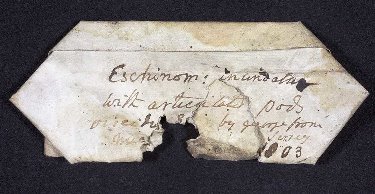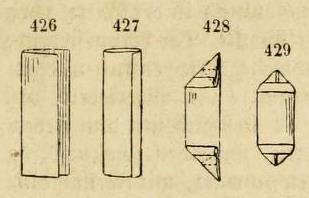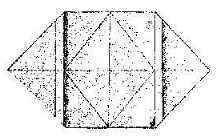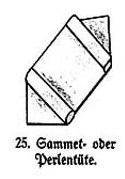| The Public Paperfolding History Project
Last updated 30/7/2025 x |
|||||||
| The Hexagonal Packet | |||||||
| This
page is being used to collect information about the
history of the paperfolding design I call The Hexagonal
Packet. Please contact me if you know any of this
information is incorrect or if you have any other
information that should be added. Thank you. ********** 1803 In the early 1990's a large number of rodent-chewed Hexagonal Packets containing seeds were discovered in the attic of The Woodlands, a historic estate in Philadelphia, once owned by the botanist William Hamilton (1735–1840). Some of these bear dates. Others are labelled in the handwriting of William Hamilton himself or his neighbour William Bartram (1739-1823), who was also a plant collector. The example pictured below is dated 1803.
********** 1864 The first diagrams for this design that I know of occur in 'Spielbuch fur Knaben' by Hermann Wagner, which was published by Verlag von Otto Spamer in Leipzig in 1864, although the foreword is dated May 1863, which argues that the book was complete at that date. It is called 'Ein Papiertute' (a paper bag).
********** 1865 The same design appears, using the same illustration, in 'Spielbuch fur Madchen' by Maria Leske (a pseudonym of Marina Krebs), which was published by Verlag von Otto Spamer in Leipzig in 1865. ********** The design also appears: 1869 As 'Peperhuisje' in 'De Kleine Natuurkundige' by Pieter Beets, which was published by D Noorthoven Van Goor in Leiden. The work is undated but said to be from 1869.
********** 1897 As 'Sachet des jardiniers' in 'Pliage et Decoupage du Papier' by C Savineau, which was published by Librairie Hatchette et Cie in Paris in 1897.
********** 1900 As 'Bolsita para semillas' (Seed Bag)' in an article in El Monitor 327 of 31st May 1900.
********** 1902 As 'Bolsa de jardinero' in 'Guia Practica del Trabajo Manual Educativo' by Ezequiel Solana, which was published by Editorial Magisterio Español in Madrid in 1902.
********** 1903 In 'La Ensenanza del Trabajo Manuel' by Pedro de Alcántara García and Teodosio Leal y Quiroga, which was published in Madrid in 1903, where it is described as a packet for seeds.
********** 1910 As 'Die Sammet oder Perlentüte' (velvet or pearl bag) in Part 2 'Das Flechten' of 'Die Frobelschen Beschaftigungen' by Marie Muller-Wunderlich, which was published by Friedrich Brandstetter in Leipzig in 1910.
********** As 'Tute' (Bag), from a 3x4 rectangle, in 'Allerlei Papierarbeiten' by Hildergard Gierke and Alice Kuczynski, which was published by Drud und Verlag B G Teubner in Leipzig and Berlin in 1910.
********** |
|||||||










